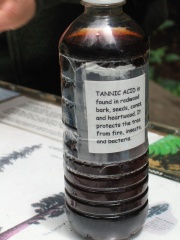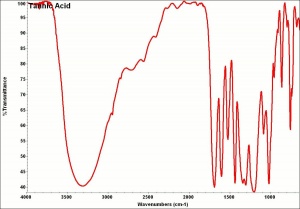Difference between revisions of "Tannic acid"
(username removed) |
(Fixed internal links) |
||
| Line 2: | Line 2: | ||
== Description == | == Description == | ||
| − | A yellowish-white amorphous powder that is strongly astringent. Tannic acid occurs naturally in [ | + | A yellowish-white amorphous powder that is strongly astringent. Tannic acid occurs naturally in [[gall|nutgalls]], tree barks (especially [[oak bark|oak]] and [[sumac]]) and other plant parts ([[tea leaves]]). Tannic acid has been used since ancient times as a mordant for dyeing. It gives a blue-black color with iron salts. Tannic acid reacts with proteins ([[animal skin|skin]], [[albumin]], [[gelatin]], etc.) to form insoluble products that are resistant to degradation. Because of this, tannic acid is an important tannin used to produce [[leather]]. It is also used in inks, photographic emulsions, and as a sizing agent for [[paper]] and [[silk]]. Tannic acid was used in the manufacture of imitation [[horn]] and [[tortoiseshell]]. Additionally, it has been used to treat [[bronze disease]] and to convert [[rust]] to a stable ferric tannate salt. |
== Synonyms and Related Terms == | == Synonyms and Related Terms == | ||
Revision as of 23:30, 14 February 2016
Description
A yellowish-white amorphous powder that is strongly astringent. Tannic acid occurs naturally in nutgalls, tree barks (especially oak and Sumac) and other plant parts (Tea leaves). Tannic acid has been used since ancient times as a mordant for dyeing. It gives a blue-black color with iron salts. Tannic acid reacts with proteins (skin, Albumin, Gelatin, etc.) to form insoluble products that are resistant to degradation. Because of this, tannic acid is an important tannin used to produce Leather. It is also used in inks, photographic emulsions, and as a sizing agent for Paper and Silk. Tannic acid was used in the manufacture of imitation Horn and Tortoiseshell. Additionally, it has been used to treat Bronze disease and to convert Rust to a stable ferric tannate salt.
Synonyms and Related Terms
gallotannic acid; tannin; gallotannin; penta-(m-digalloyl)-glucose; digallic acid (incorrectly)
Other Properties
Soluble in water, ethanol, acetone. Insoluble in benzene, chloroform, ether, carbon disulfide. Gives precipitates with most metal salts, proteins and alkaloids.
| Composition | C76H52O46 |
|---|---|
| CAS | 1401-55-4 |
| Melting Point | 210-215 (dec) |
| Molecular Weight | mol. wt. = 1700.3364 |
Hazards and Safety
Toxic by ingestion and inhalation. Concentrated tannic acid is corrosive to skin. Combustible.
Mallinckrodt Baker: MSDS
Additional Information
° T.Stambolov, R.D.Bleck, N.Eichelmann, Korrosion und Konservierung von Kunst und Kulturgut aus Metall, Weimar, 1987.° N.Binnie, 'Commercial Rust Conserverters: Surface Protection for Rusted Iron', Canadian Conservation Institute Publications, Conservation Information Database.
Authority
- Palmy Weigle, Ancient Dyes for Modern Weavers, Watson-Guptill Publications, New York, 1974
- John and Margaret Cannon, Dye Plants and Dyeing, Herbert Press, London, 1994
- F. Crace-Calvert, Dyeing and Calico Printing, Palmer & Howe, London, 1876 Comment: p. 311
- Judith Hofenk-de Graaff, Natural Dyestuffs: Origin, Chemical Constitution, Identification, Central Research Laboratory for Objects of Art and Science, Amsterdam, 1969
- Wikipedia, the free encyclopedia, at http://www.wikipedia.com Comment: http://en.wikipedia.org/wiki/Tannic_acid (Accessed Sept. 28, 2005)
- Richard S. Lewis, Hawley's Condensed Chemical Dictionary, Van Nostrand Reinhold, New York, 10th ed., 1993
- Matt Roberts, Don Etherington, Bookbinding and the Conservation of Books: a Dictionary of Descriptive Terminology, U.S. Government Printing Office, Washington DC, 1982
- The Merck Index, Martha Windholz (ed.), Merck Research Labs, Rahway NJ, 10th edition, 1983 Comment: entry 8221
- Susan E. Schur, Conservation Terminology: A review of Past & Current Nomenclature of Materials, Technology and Conservation, Spring (p.34-39); Summer (p.35-38); Fall (p.25-36), 1985
- Tom Rowland, Noel Riley, A-Z Guide to Cleaning, Conserving and Repairing Antiques, Constable and Co., Ltd., London, 1981
- Michael McCann, Artist Beware, Watson-Guptill Publications, New York City, 1979
- Random House, Webster's Encyclopedic Unabridged Dictionary of the English Language, Grammercy Book, New York, 1997
- External source or communication Comment: Submitted information from Budiga Goran, May 2005
- The American Heritage Dictionary or Encarta, via Microsoft Bookshelf 98, Microsoft Corp., 1998
- Art and Architecture Thesaurus Online, http://www.getty.edu/research/tools/vocabulary/aat/, J. Paul Getty Trust, Los Angeles, 2000

